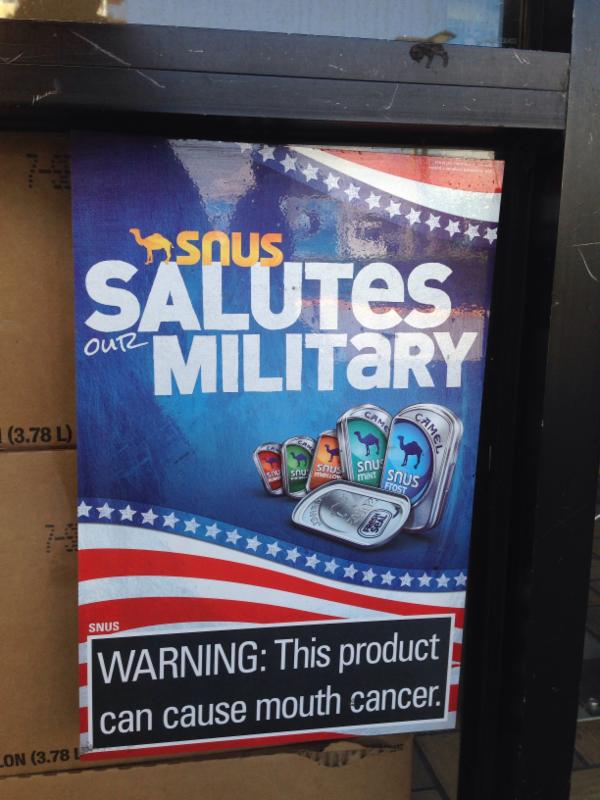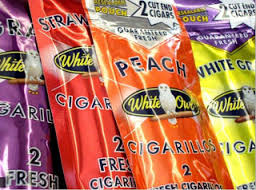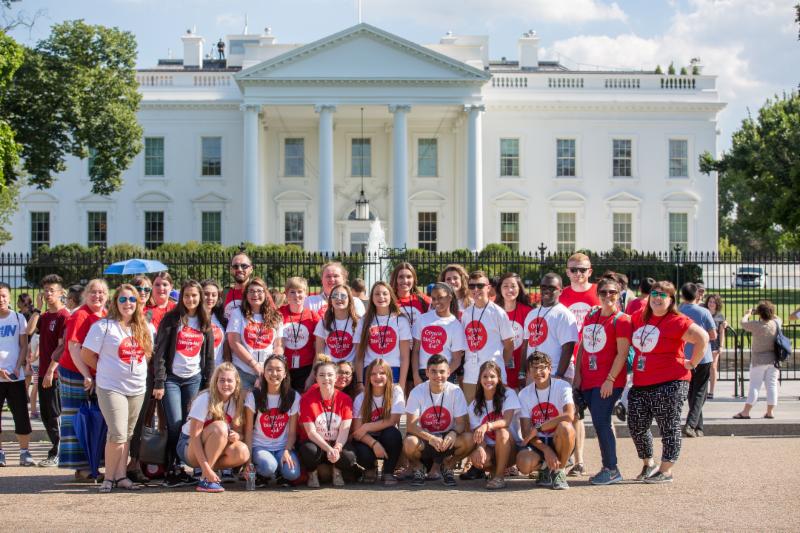Each year Counter Tobacco hosts a photo contest to replenish the Counter Tobacco media gallery with up-to-date images, encouraging users to take photos of the tobacco point of sale. These images are crucial to educating the public and furthering the success of efforts that seek to reduce tobacco industry activity at the point of sale. Prize packs include Counter Tobacco swag!

Grand prize winning photograph in 2015 captured by Nicole S. in Ft. Lauderdale, FL.
Rates of tobacco use are higher in the military than in the civilian population, which can reduce readiness and cause adverse health outcomes. In 2011, 12.8% of all military personnel used smokeless tobacco products like snus compared to 3.2% of the general population. Learn more about tobacco’s impact on the military in this Tobacco Use in the Military fact sheet from the Campaign for Tobacco Free Kids.
The current photo contest runs from August 8 through September 6. For contest rules and entry, click here.
The Food and Drug Administration’s (FDA’s) deeming rule went into effect on August 8, 2016. The rule extends the agency’s regulatory authority to tobacco products including electronic nicotine delivery systems (ENDS) such as e-cigarettes and vape pens; all cigars; hookah (waterpipe) and pipe tobacco; nicotine gels; and certain dissolvables.
Although the rule itself is considered effective on August 8, only some provisions require compliance as of that date. Major provisions that become effective on or around this date can be found on the FDA website. A chart of effective and compliance dates is also available online, and the final rule provides comprehensive information.
The Wisconsin Nicotine Treatment Integration Project has a free, online tutorial that provides easy-to-access, practical guidance about how to integrate tobacco cessation into policies and treatment protocols into behavioral health programs.
The tutorial highlights the experience of behavioral health clinicians and administrators who have integrated tobacco and behavioral health treatment and includes twelve modules. Interactive components of each module allow users to develop a tailored Tobacco Integration Plan.
Please share this resource with behavioral health providers and facilities.
A recent study in Tobacco Regulatory Science (July 1, 2016) examines little cigar and cigarillo (LCC) adult user characteristics, perceived addictiveness, use and importance of flavors, intentions to continue use, and reasons for use to inform prevention efforts and regulatory policy.

Results show that current LCC smokers were more likely to be male, younger, black or Hispanic, lower socioeconomic status, current cigarette smokers, and report poorer health than non-smokers. Perceived addictiveness was low overall, with 73.6% considering themselves “not at all” addicted, although female LCC users and dual users of cigarettes were more likely to consider themselves addicted to LCCs. Use of flavored LCCs was widespread. Flavors were cited as important reasons for use, especially among younger users, as were favorable comparisons with affordability and burn time of cigarettes.
Cigar use is at least as harmful as cigarette use, and the risk of harm increases with the frequency and intensity of use. (PubMed: 10927783 and 26459155)
For more information, access the full article here.
The Center for Disease Control and Prevention’s Division of Adolescent and School Health (DASH) has released a new study on lesbian, gay and bisexual (LGB) youth, containing 2015 national, state, and local Youth Risk Behavior Survey (YRBS) sexual minority results in a Morbidity and Mortality Weekly Report (MMWR) Surveillance Summary. The study highlights important findings from the first nationally representative sample of LGB student health behaviors reported from YRBS (Grades 9 through 12). Study results showed that LGB students experience substantially higher levels of tobacco use, physical and sexual violence, and bullying than other students.
Some of the highlights regarding tobacco-related findings among LBG youth:
Access to the full report can be found here.

Multiunit housing residents are at risk of secondhand smoke exposure from adjoining units and common areas. A recent article entitled, State Tobacco Control Program Implementation Strategies for Smoke-Free Multiunit Housing, (Health Promotion Practice, July 8, 2016 Epub ahead of print), documents state-level strategies undertaken to address this risk.
Researchers explored program documents to identify facilitators, barriers, and outcomes. Three states (Montana, Michigan, and Nebraska) provided detailed information on multiunit housing efforts in the study time frame. Existing infrastructure was examined, including traditional and nontraditional partnerships, leadership and champions. The article also examines how data was collected and used, efficient use of resources, and external catalysts, barriers, and outcomes.
States recommend starting with public housing authorities, so they can become resources for affordable and subsidized housing. These lessons and resources can be used to inform smoke-free multiunit housing initiatives in other states and localities.

Brooklyn Larimore, the Youth Board Co-Chair for Nebraska’s No Limits youth advocacy movement, was recently selected by the Campaign for Tobacco Free Kids to serve as a 2016-2017 National Youth Advocate. One of the requirements of being a National Youth Advocate was to attend the Campaign for Tobacco Free Kids Youth Advocacy Symposium in Washington D.C. on July 10-14.
While at the Symposium, Brooklyn met with Representative Jeff Fortenberry and Senator Ben Sasse. During the meeting (as a National Youth Advocate, not as a No Limits member) she discussed the need for h4 action to protect kids from newer tobacco products, including electronic cigarettes and flavored cigars that have become popular with kids. Brooklyn is the third person from the right in the back row of the above photo.

Results from the 2011-2012 Medical Expenditures Panel Survey (MEPS) show that smoking was reported by 18% of 2012 MEPS respondents. Less than half of adult smokers (47%) were advised to quit by their physicians although a little more than 17% had not seen a doctor in the last 12 months.
Advice to quit was given significantly less often to respondents classified as: aged 18-44 (40%), men (40%), less educated (42%), lower family income (44%), Hispanic (34%), never married (40%), and living outside the northeast. Advice to quit smoking was less common than the use of common medical screening tests.
The article, Provider’s advice concerning smoking cessation: Evidence from the Medical Expenditures Panel Survey, in Preventive Medicine (July 27, 2016 Epub ahead of print),
shows that smoking cessation advice is given to less than half of current cigarette smokers and it is least likely to be given to the most vulnerable populations. The rate of advice to quit has not changed over the last decade.
The Nebraska Tobacco Quitline, a cessation service of Tobacco Free Nebraska, provides tools for health care providers that can assist their patients in utilizing the Quitline. To access these resources, visit QuitNow.ne.gov.
Annual Nebraska Rural Health Association Conference, Sept. 21-22 at Younes Conference Center in Kearney. For more information and to register, click here.
Public Health Association of Nebraska’s annual conference at the Embassy Suites in Lincoln. Registration information available here.
Tobacco Free Nebraska State Coalition meeting Oct. 18, 11:30 a.m. to 2:00 p.m. More information to come.
Abstract submission deadline is September 30. Registration is open and available here.
|
Quick Links |

Comments